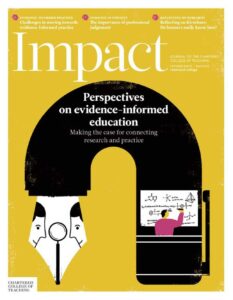Welcome editorial

As guest editor, I am delighted to welcome you to the interim issue of Impact. It is the first journal to be published under the umbrella of the Chartered College of Teaching, the newly opened professional membership body for the teaching profession.
Whilst this interim issue does not yet represent what our fully established peer-reviewed journalA journal in which research papers are evaluated by experts ... More will be, it is an indication of what is to come, and, in its theme of evidence-informed practice, sets both the standard and the context of the full journal, which will launch in
September this year. It not only builds on the long-standing traditions and reputation of Education Today, the journal of the College of Teachers, but also showcases the first steps in a move towards a new journal that is truly focused on the interests and voices of teachers and educators, whilst being informed by evidence and research throughout.
Our new approach is at the core of every aspect of the new journal. Its name — Impact — reflects our desire for this journal to be something that can have a tangible effect on classroom practice and, subsequently, on the outcomes of our young people, whilst also referencing the importance of enabling outputs from higher education to be more widely accessible and more widely used. The new journal will connect research findings to classroom experience, promote discussion around evidence and research methods within the teaching community, and enable teachers to share and reflect on their own use of research. The voices represented are wide-ranging and recognise the importance of context
and professional judgment in informing decision-making. They do not dictate a particular approach; instead, they aim to promote and encourage thought and debate — something that will be possible through our digital edition, with extensive commenting features available online, as well as related videos and further examples. I believe that it is through collaboration, discussion and critical engagement with evidence that we will start to see it permeating our classrooms, so I encourage you to both explore the different sections of this journal and reflect on their implications for your own practice.
Each termly issue will be themed around a critical topic for practitioners — starting with the theme of assessment in September — with a guest editor who is a specialist in the field, and a wide range of research articles and expert perspectives from teachers and academics — and, increasingly, both at the same time.
This interim issue takes a tripartite approach to addressing the theme of evidence-informed practice. Firstly, practitioners and researchers in the field explore the question of what we mean by ‘evidence-informed practice’ and what it actually looks like in practice. Specific examples of evidence use and the implications of engaging in evidence-informed practice follow, then the final section hears teachers across a range of settings explaining how they have implemented a concept from a piece of published education research in their practice, with summaries of the articles they reference available as part of the digital edition, providing the reader with both an understanding of seminal research papers and insights into how they might be used in the classroom.
The readership of this journal is wide; teachers, school leaders, researchers and others involved in education in a range of different roles and settings are represented within. Inevitably, this also means that some articles will be of more relevance than others. I hope, however, that you will find something that is of use to you — and that, having explored this edition, you will pick up our first full edition in September with interest and enthusiasm. I hope, too, that some of you will feel inspired to submit contributions for future editions; you can find out how to do so at the back of this issue.










